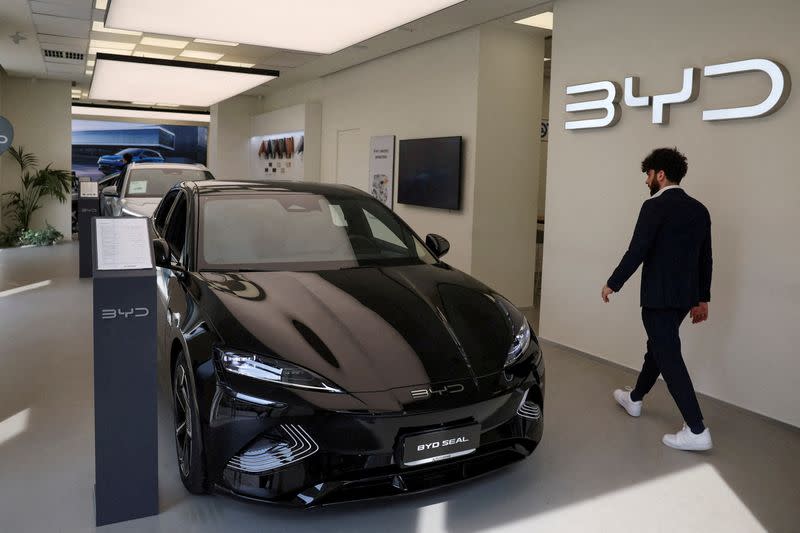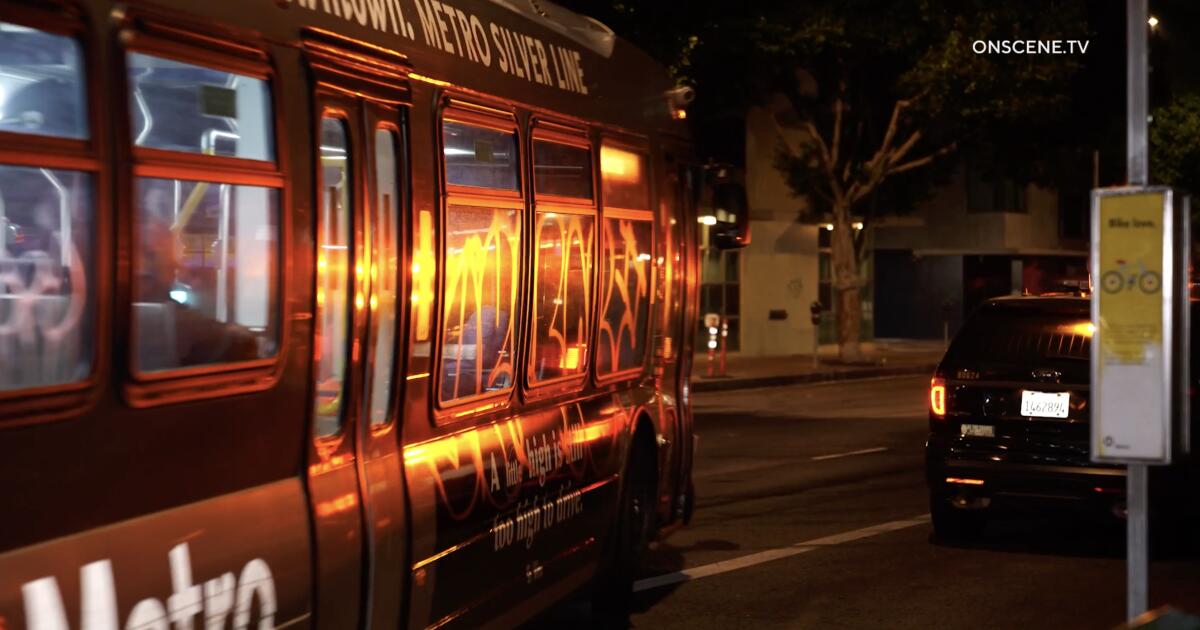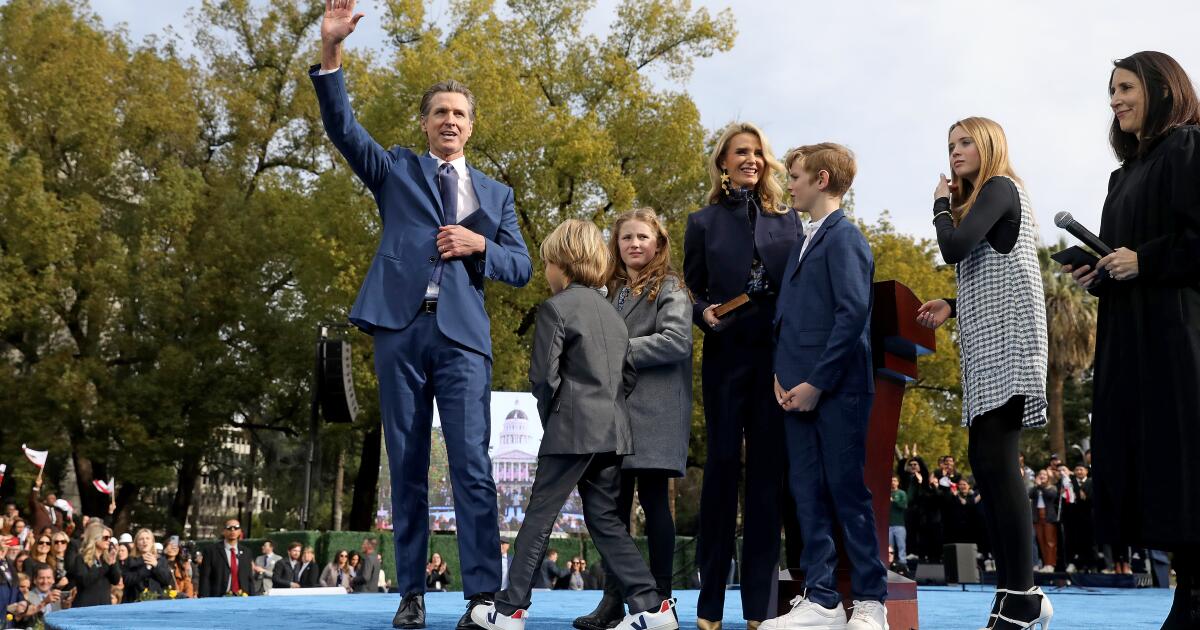World News
Why I’m welcoming Los Angeles public schools’ cellphone ban

Every time I write about smartphones taking a toll on adolescents, I get tut-tutted by critics accusing me of promoting moral panic.
That’s just silly.
I am not here to debate whether phones have contributed to an increase in anxiety, depression or low self-esteem among minors. Plenty of experts are studying that, and they are getting plenty of conflicting results.
But I am here to tell you that if you are raising a young teenager, you must know in your bones that worrying about smartphones and social media is not some irrational, “Reefer Madness”-style reaction to change.
It’s as plain as the noses on our children’s faces — which, by the way, are constantly buried in their phones. Find me a parent who does not regularly battle with their child about putting away the smartphone — at the dinner table, with friends, in the car, on the sidewalk, at the beach, at the mall, on their bicycles — and I will find you a parent who is deployed, detached or dead. Let’s be honest: Our children are addicted.
It’s very difficult to control our kids’ smartphone use outside school, but there’s no reason we can’t control their smartphone use during school. In fact, educators all over the world are coming around to that point of view.
Some schools use lockers to store the phones; others use pouches that lock until they are tapped against a magnetic device at the schoolhouse door.
In a recent Times opinion essay, Los Angeles Board of Education member Nick Melvoin called for a ban on smartphones in L.A.’s public schools.
“Curbing phone usage in the classroom increases academic performance, with test score gains akin to gains made when an hour is added to the school week,” he wrote. In Spain, he added, the test scores of students at schools that have banned smartphones have risen, accompanied by a “significant drop in cyberbullying.”
Closer to home, Melvoin noted, a few Los Angeles public schools have already implemented phone bans. “School principals in LAUSD who have implemented phone-free school day policies report that fighting is down, student engagement is up and the overall campus environment is more positive,” he wrote.
Melvoin’s resolution directing the district’s staff to develop a phone ban was passed by the board Tuesday.
Fortunately, the chorus for banning smartphones in schools is getting louder.
Last month, the California Assembly passed a bill that would prohibit smartphone use by students in public schools. The bill is now being considered in the state Senate.
On Monday, the U.S. surgeon general, Dr. Vivek Murthy, said he would ask Congress to require warning labels on social media apps.
“It is time to require a surgeon general’s warning label on social media platforms, stating that social media is associated with significant mental health harms for adolescents,” he wrote in the New York Times. A warning label, he wrote, “would regularly remind parents and adolescents that social media has not been proved safe.”
Smartphones have been causing tension in my home for years. After my niece moved in with me in 2019, at age 8, she talked incessantly about wanting a phone. Later, we signed the “Wait Until 8th” pledge not to get her one until the end of middle school, but she hounded me for an iPhone sooner because most of her friends had one. I was determined to hold the line, and did.
Man, though, was she persistent. In seventh grade, she composed a 10-point declaration, “Reasons I Should Get an iPhone.”
She was hardly device-deprived. She had a Gabb phone, which looks like an iPhone but can be used only to make and receive phone calls, texts and photos. It’s not internet-equipped, so it has no apps or social media. But she did have an iPad and access to Snapchat, her preferred social media platform, and Roblox, the game app, to play with friends.
She was smart about how she ordered her argument for a smartphone, starting with logic and then going for the emotional jugular.
“Number 1) To scan QR codes: I need to for my whole life because people don’t wanna make paper menus or just print out things anymore.”
I had noticed that displays at her middle school’s science fair included QR codes for information about the experiments. Some school announcements also included QR codes. If she could not scan them, would she be missing out on important information?
“Number 2) Listen to music: I picked this one because I have to record stuff on my phone to listen to music. Also, if you’re about to say what about your iPad, I can’t carry my iPad walking home from school.”
And then, clever girl, she played the fear card:
“Number 5) Facetime: On my phone, I can only call audio. I would like Facetime in case I need to tell someone where I am for emergencies.”
“Number 7) Looking up things: If I am ever walking home or alone anywhere I would wanna be able to look where I am. Or how to get out of wherever I am.”
All that is true, of course.
But one of the beautiful things about smartphones is the “Find My” function. Using my smartphone, I can always see where she is, or at least where her phone is.
If it’s safely locked away during school hours, so much the better.
World News
The toll of extreme heat is rising in California

As California heads into a dangerous holiday heat wave that will blanket millions of residents in triple-digit temperatures, state and federal officials are vowing to do more to address the worsening threat — and the rising costs — of extreme heat.
On Tuesday, the U.S. Department of Labor’s Occupational Safety and Health Administration, or OSHA, announced that it will advance a proposed rule to protect indoor and outdoor workers from high temperatures at the national level. If finalized, the regulations would establish temperature-based standards for an estimated 35 million workers in places such as warehouses, kitchens, farms and construction sites.
The proposal, which has been in the works since 2021, would apply to workplaces where the heat index regularly rises above 80 degrees, according to senior administration officials. It would follow similar moves from California, which became the first state in the nation to establish permanent heat protections for outdoor workers in 2006 and approved heat regulations for indoor workers just last month.
Officials said such rules are needed as extreme heat claims more lives and as the nation grapples with more frequent and severe weather events fueled by climate change. Last year, the U.S. saw a record 28 disasters that exceeded $1 billion in losses, which caused more than $90 billion in aggregate damage.
At the same time, California’s Department of Insurance this week released a first-of-its kind analysis revealing $7.7 billion in insurance losses tied to extreme heat events over the last decade. The report quantifies the uninsured and insured costs of seven recent extreme heat events in the state and highlights the need for adaptive strategies.
It joins a growing body of evidence about extreme heat’s toll — from mounting heat-related illnesses and fatalities to biodiversity impacts, economic effects, agricultural losses and infrastructure damage. Heat has contributed to more deaths over the last 30 years than hurricanes, floods and tornadoes combined, making it the deadliest of all U.S. climate hazards, according to the National Weather Service. Last year was the planet’s hottest year ever recorded.
“Extreme heat is a silent, escalating disaster that threatens our health, economy, and way of life in California,” read a statement from Insurance Commissioner Ricardo Lara. “This report brings to light the staggering hidden costs of extreme heat events, underscoring the urgency of our efforts to create a groundbreaking heat wave ranking and early warning system statewide. We must prioritize resilience-building efforts and innovative insurance solutions to safeguard our state against the growing impacts and financial risks of extreme heat.”
Indeed, experts have for years been pushing for more stringent surveillance of heat’s toll, with a 2021 Los Angeles Times investigation revealing that extreme heat deaths are chronically undercounted in the state. Following that investigation, Gov. Gavin Newsom signed into law a bill to create a heat wave ranking system similar to those used for hurricanes. The system is slated to be in place by Jan. 1, 2025.
Newsom also in recent years launched an extreme heat awareness campaign, urban greening programs and other efforts to help residents prepare for and adapt to worsening heat; however some of those programs received cuts amid this year’s budget deficit.
Though the $7.7 billion cost associated with heat events is substantial, the Department of Insurance estimated that the true toll is likely higher. While some kinds of insurance do cover costs connected to extreme heat — such as health coverage, workers’ compensation insurance and crop insurance — there are gaps that will require new mechanisms and investments, the agency said. The state is currently facing a separate insurance crisis related to worsening wildfires.
Other costs associated with heat include labor productivity losses, which ranged from $7.7 million to $210 million per event, according to the report. Infrastructure repair costs due to heat-related damage ranged from $3.8 million to $35 million per event, predominantly affecting roads and rails, while power outages during heat waves resulted in substantial economic impacts up to $230 million.
One of the heat events covered in the report — a prolonged heat wave in September 2022 — pushed California’s power grid to the brink and prompted an emergency text message from the state’s energy operators asking residents to conserve power, narrowly avoiding a blackout.
That same heat wave was later determined to have killed 395 Californians, according to state health officials, who also reported that its worst affects were among Latinos and working-age people between ages 25 and 64.
The Department of Insurance’s report similarly underscored the ways in which extreme heat disproportionately affects communities of color, low-income communities and vulnerable populations such as seniors and children.
Jonathan Parfrey, executive director of Climate Resolve, said the report’s admittedly conservative estimates are “nonetheless staggering.”
“A hot day is not just an inconvenience — for hundreds of thousands of Californians, extreme heat is a matter of life and death,” Parfrey said, adding that the losses in labor productivity alone should be a wake-up call to industry and policymakers. “The lesson is this: investing in cooling solutions today will save money and lives tomorrow.”
But strengthening workplace protections will also help save lives, White House officials said.
OSHA’s proposed rule, which will be sent to the federal register and made available for public comments, would require workplaces to establish heat illness and injury prevention plans that are evaluated at least once a year; to provide workers with access to drinking water and cool-down areas and to respond to symptoms of heat illness and emergencies, among other measures.
Additional protections would be triggered at temperatures of 90 degrees or hotter, including mandatory rest breaks and symptom monitoring.
States such as California, which already have workplace heat regulations in place, would have to have meet the minimum federal requirements but can go further, officials said. States such as Florida and Texas — which have passed laws blocking cities or employers from establishing heat rules — would also have to comply with the federal rule or face significant penalties for violations.
The proposed rule joins other efforts from the Biden Administration to address worsening heat and climate hazards, including a new heat risk tool from the National Weather Service; cooling assistance programs for low-income households and expanded investments in trees and green spaces.
The Federal Emergency Management Agency on Tuesday also announced that it will make available $1 billion in funding for its Building Resilient Infrastructure and Communities program to help communities reduce their risk from disasters and natural hazards, including extreme heat, wildfires, droughts, hurricanes, earthquakes and floods.
The funding includes 656 projects across the nation, including considerable investments in disadvantaged communities, agency officials said.
However, FEMA continues to face pressure from environmental groups and labor organizations urging it broaden its definition of “major disasters” to include extreme heat, which advocates say would unlock additional avenues of funding during heat waves and help states and communities better prepare for rising temperatures.
Already this year, FEMA and other federal agencies have responded to more than a dozen disasters, including devastating wildfires in New Mexico and historic flooding in Iowa and Minnesota, officials said.
They are currently monitoring Hurricane Beryl — which became the first hurricane on record to reach Category 4 in the month of June — as well as the record-breaking heat slated to smother much of the country this week.
But heat waves continue to pose unique dangers, with the average length of the heat wave season now 46 days longer than it was in the 1960s, according to a new report from the U.S. Environmental Protection Agency.
In California, officials warned that the incoming heat wave could also lead to wildfires as soaring temperatures coincide with fireworks, barbecues and other Fourth of July-related activities. State officials are warning that power shutoffs are possible in some Northern California counties, where temperatures could soar as high as 110 degrees.
Portions of the Central Valley and the Antelope Valley may also climb to 110 degrees, while the Coachella Valley could bake at 121 degrees and Death Valley at 125 degrees.
The heat wave is expected to linger for days, forecasters said — with some parts of the Golden State not likely to see relief until at least the start of next week.
World News
China’s BYD posts 21% jump in quarterly EV sales, closes gap with Tesla
BEIJING (Reuters) – China’s BYD (BYDDY) posted a 21% rise in second-quarter electric vehicle sales, closing the gap with Tesla (TSLA) after handing back the world’s top EV vendor title to the U.S. rival in the first quarter.
BYD sold 426,039 EVs in the April-June quarter, according to Reuters’ calculations based on its monthly sales reports. That’s around 12,000 vehicles fewer than Tesla’s vehicle deliveries estimated for the second quarter.


Tesla is expected to report a 6% drop in April-June quarter vehicle deliveries on Tuesday, the first time the U.S. firm is set to post two straight quarters of decline, as it deals with stiff competition in China and slow demand due to a lack of affordable new models.
The company may again cede its EV championship to BYD if the actual results turn out to be softer than estimated, with Barclays predicting an 11% drop in second-quarter deliveries, Tesla’s biggest ever.
Tesla has hit a speed bump after years of rapid growth that helped make it the world’s most valuable automaker. It warned in January that deliveries growth in 2024 would be “notably lower” as a boost from months-long price cuts wanes.
The EV maker has cut output of its best-selling Model Y electric car by a double-digit percentage number at its Shanghai plant since March to address weakening demand for its aged models in China, its second-largest market after the United States, Reuters reported in May.
By comparison, its top Chinese competitor BYD maintained steady growth in EV sales, while EV upstarts such as Nio reported stellar growth last quarter. NIO’s vehicle deliveries in the second quarter more than doubled to 57,300 units.
Price cuts and a growing shift in consumer demand to EVs and hybrids from gasoline-powered vehicles are the main reasons behind Chinese EV makers’ strong sales in recent months, said Cui Dongshu, secretary general, China Passenger Car Association (CPCA).
Sales of new energy vehicles including EVs and plug-in hybrids in China made up 46.7% of total car sales in May, a fresh monthly high, as per CPCA data.
(Reporting by Qiaoyi Li, Zhang Yan and Kevin Krolicki; Editing by Miyoung Kim and Sherry Jacob-Phillips)
World News
Biden slams SCOTUS presidential immunity ruling, ignores questions about dropping out

President Biden slammed the Supreme Court’s ruling on presidential immunity in Trump v. United States, saying it means there are virtually no limits on what a president can do, in a speedy address Monday evening.
The president spoke for less than five minutes – four minutes and 40 seconds to be exact – before turning his back to the press and walking away.
“This is a fundamentally new principle, and it’s a dangerous precedent, because the power of the office will no longer be constrained by the law, even including the Supreme Court of the United States,” Biden said.
The Supreme Court ruled that a former president has substantial immunity from prosecution for official acts committed while in office, but not for unofficial acts.
TRUMP IMMUNITY CASE: SUPREME COURT RULES EX-PRESIDENTS HAVE SUBSTANTIAL PROTECTION FROM PROSECUTION

Trump and Biden squared off in their high-stakes 2024 election debate rematch last week. (Justin Sullivan/Getty Images, left, )
In a 6-3 decision, the Court sent the matter back down to a lower court, as the justices did not apply the ruling to whether or not former President Trump is immune from prosecution regarding actions related to efforts to overturn the results of the 2020 election.
Biden continued his address, saying that the American people must decide whether Donald Trump’s assault on democracy on January 6th makes him “unfit” for public office and the highest office in the land.
“The American people must decide if Trump’s embrace of violence to preserve his power is acceptable. Perhaps most importantly, the American people must decide if they want to entrust the presidency to Donald Trump once again. Now knowing, he’ll be even more emboldened to do whatever he pleases, whenever he wants to do it,” Biden said.
Biden also spoke about the character of the nation’s first president, George Washington, and how he believed power was limited, not absolute.
Biden wrapped his speech and dodged questions from reporters as he left abruptly.
Reporters shouted questions at Biden, asking him if he plans to drop out of the presidential race following his debate with Trump.

US President Joe Biden speaks during a Memorial Day address at Arlington National Cemetery in Arlington, Virginia, US, on Monday, May 27, 2024. (Bonnie Cash/UPI/Bloomberg via Getty Images)
Biden has not taken questions from the press and has used teleprompters at his events, including a fundraiser in the Hamptons, following his disastrous debate performance against Trump last week.
“Today’s Historic Decision by the Supreme Court should end all of Crooked Joe Biden’s Witch Hunts against me, including the New York Hoaxes – The Manhattan SCAM cooked up by Soros backed D.A., Alvin Bragg, Racist New York Attorney General Tish James’ shameless ATTACK on the amazing business that I have built, and the FAKE Bergdorf’s “case.” PROUD TO BE AN AMERICAN!,” Trump wrote in a post on his social media site Truth Social.
BIDEN CAMP DISMISSES TRUMP IMMUNITY RULING: ‘DOESN’T CHANGE THE FACTS’

Trump pleaded not guilty to all charges and argued he should be immune from prosecution from official acts done as president of the U.S. (Michael M. Santiago/Getty Images)
The former president was charged in August 2023 by Special Counsel Jack Smith with conspiring to overturn the results of his election loss to President Biden in the run-up to the Jan. 6, 2021, riot at the U.S. Capitol.
Trump has denied doing anything wrong and has said this prosecution and three others are politically motivated to try to keep him from returning to the White House.
Trump shared his reaction to the Supreme Court’s ruling on his presidential immunity case, saying it’s a “big win for our constitution and democracy,” according to his Truth Social page.
CLICK HERE TO GET THE FOX NEWS APP
“THE SUPREME COURT DECISION IS A MUCH MORE POWERFUL ONE THAN SOME HAD EXPECTED IT TO BE. IT IS BRILLIANTLY WRITTEN AND WISE, AND CLEARS THE STENCH FROM THE BIDEN TRIALS AND HOAXES, ALL OF THEM, THAT HAVE BEEN USED AS AN UNFAIR ATTACK ON CROOKED JOE BIDEN’S POLITICAL OPPONENT, ME. MANY OF THESE FAKE CASES WILL NOW DISAPPEAR, OR WITHER INTO OBSCURITY. GOD BLESS AMERICA!” Trump posted.
Fox News Digital’s Brooke Singman and Brianna Herlihy contributed to this report.
-

 African History5 years ago
African History5 years agoA Closer Look: Afro-Mexicans 🇲🇽
-

 African History5 months ago
African History5 months agoBlack History Facts I had to Learn on My Own pt.6 📜
-

 African History5 years ago
African History5 years agoA Closer Look: Afro-Mexicans 🇲🇽
-

 African History1 year ago
African History1 year agoMajor African Tribes taken away during the Atlantic Slave Trade🌍 #slavetrade #africanamericanhistory
-

 African History1 year ago
African History1 year agoCameroon 🇨🇲 World Cup History (1962-2022) #football #realmadrid #shorts
-

 African History1 year ago
African History1 year agoPROOF AFRICAN AMERICANS AIN'T FROM AFRICA DOCUMENTED EVIDENCE
-

 African History5 months ago
African History5 months agoBlack History Inventors: Mary Kenner 🩸
-

 African History5 months ago
African History5 months agoMr Incredible Becoming Canny/Uncanny Mapping (You live in Paraguay 🇵🇾)





























